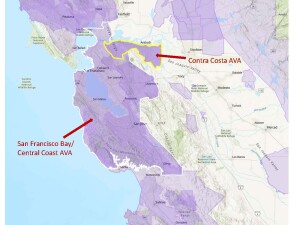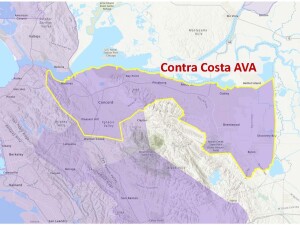On March 15 (2024), the TTB (Alcohol and Tobacco Tax and Trade Bureau) of the United States announced the approval of the Contra Costa American Viticultural Area (AVA). The new AVA covers a portion of California’s Contra Costa County, located in the East Bay portion of the San Francisco Bay Area. Along with the approval of the new AVA, the San Francisco Bay AVA and the Central Coast AVA have been expanded so that they encompass the entirety of the new appellation. In other words, the Contra Costa AVA is a sub-appellation of both the San Francisco Bay AVA and the Central Coast AVA.
According to the original petition—submitted by Patrick Shabramon on behalf of the Contra Costa Winegrowers Association in March of 2023—the distinguishing features of the Contra Costa AVA include its topography and climate—as described below.
Topography: The terrain of the Contra Costa AVA is—while interrupted in a few places by rolling hills—relatively flat. All of the area within the boundaries of the new AVA are below 1,000 feet, with most area below 100 feet. Hillside slopes—where they exist—are generally less than 5% gradient. As such, the area experiences a great deal of marine influence from the northeastern portion of the San Francisco Bay—including San Pablo Bay and Suisun Bay.
Climate: The Contra Costa AVA experiences an average of 3,000 to 4,275 GDD (growing degree days) over the course of a growing season, marking the area as a relatively warm (and sometimes very warm) region. However, the area’s proximity to the marine influence from the northeastern portion of the San Francisco Bay—including San Pablo Bay and Suisun Bay—mean that temperatures cool down quite a bit at night. This diurnal temperature fluctuation provides the area with a near-ideal grape-growing climate scenario of “warm days—cool nights.“
The Central Coast AVA covers a total of 167,146 acres; of these, approximately 1,700 acres are currently planted with commercial vineyards. Leading grape varieties include Zinfandel, Petite Sirah, Mourvèdre, Cabernet Sauvignon, and Chardonnay.
The area around Contra Costa County has been growing grapes and producing wine since 1846. By 1916, there were over 6,000 acres of vines in the area. Alas, most of these vines did not survive Prohibition. These days, Contra Costa County is home to at least 60 commercial vineyards and 14 wineries, including Viano Vineyards, Serendipity Cellars, and Hannah Nicole Vineyards & Winery.
Cline Cellars (now located in Sonoma) was established in this area (in the town of Oakley) in 1982. Cline Cellars still sources grapes from Contra Costa, and I am an enthusiastic fan of their Contra Costa County Old Vine Zinfandel.
When the Contra Costa AVA is brought into force—on April 15, 2024—the total number of AVAs in the United States will be 270; of these, 150 will be in California.
Welcome to the world, Contra Costa AVA!
References/for more information:
- TTB Rule – Contra Costa AVA
- Proposal to Establish the Contra Costa AVA
- Website of the Contra Costa Winegrowers Association
Post authored by Jane A. Nickles…your blog administrator: jnickles@societyofwineeducators.org

